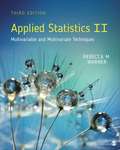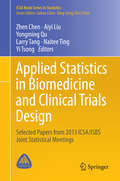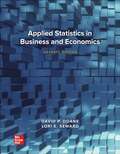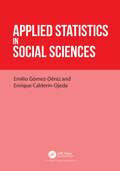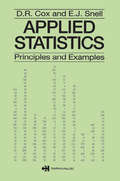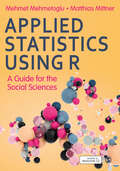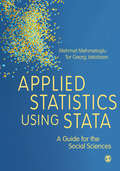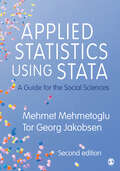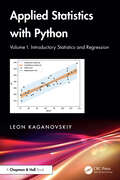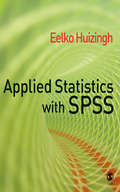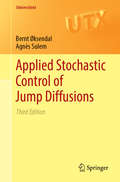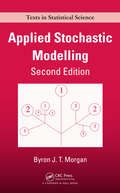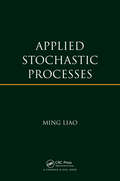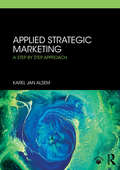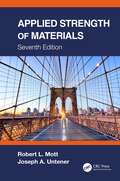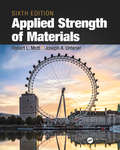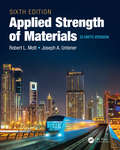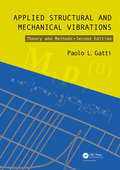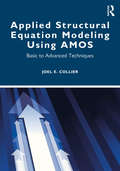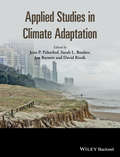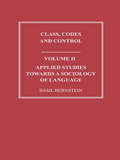- Table View
- List View
Applied Statistics II: Multivariable and Multivariate Techniques
by Rebecca M. WarnerRebecca M. Warner&’s bestselling Applied Statistics: From Bivariate Through Multivariate Techniques has been split into two volumes for ease of use over a two-course sequence. Applied Statistics II: Multivariable and Multivariate Techniques, Third Edition is a core multivariate statistics text based on chapters from the second half of the original book. The text begins with two new chapters: an introduction to the new statistics, and a chapter on handling outliers and missing values. All chapters on statistical control and multivariable or multivariate analyses from the previous edition are retained (with the moderation chapter heavily revised) and new chapters have been added on structural equation modeling, repeated measures, and on additional statistical techniques. Each chapter includes a complete example, and begins by considering the types of research questions that chapter&’s technique can answer, progresses to data screening, and provides screen shots of SPSS menu selections and output, and concludes with sample results sections. By-hand computation is used, where possible, to show how elements of the output are related to each other, and to obtain confidence interval and effect size information when SPSS does not provide this. Datasets are available on the accompanying website.
Applied Statistics in Biomedicine and Clinical Trials Design: Selected Papers from 2013 ICSA/ISBS Joint Statistical Meetings (ICSA Book Series in Statistics)
by Zhen Chen Aiyi Liu Yongming Qu Larry Tang Naitee Ting Yi TsongThis volume is a unique combination of papers that cover critical topics in biostatistics from academic, government, and industry perspectives. The 6 sections cover Bayesian methods in biomedical research; Diagnostic medicine and classification; Innovative Clinical Trials Design; Modelling and Data Analysis; Personalized Medicine; and Statistical Genomics. The real world applications are in clinical trials, diagnostic medicine and genetics. The peer-reviewed contributions were solicited and selected from some 400 presentations at the annual meeting of the International Chinese Statistical Association (ICSA), held with the International Society for Biopharmaceutical Statistics (ISBS). The conference was held in Bethesda in June 2013, and the material has been subsequently edited and expanded to cover the most recent developments.
Applied Statistics in Business and Economics
by David P. Doane Lori E. SewardApplied Statistics in Business and Economics, 7th edition, provides real meaning to the use of statistics in the real world by using real business situations and real data while appealing to students who want to know the why rather than just the how. The text emphasizes thinking about data, choosing appropriate analytic tools, using computers effectively, and recognizing the limitations of statistics. It motivates student learning through applied current exercises and cases that provide real-world relevance and includes analytics in action, careers, and applications of big data, Artificial Intelligence, and machine learning (including ethical issues). The Doane and Seward authors work as a team, integrating the digital and eBook assets seamlessly. In recognition of a growing interest in analytics training beyond Excel, the textbook now provides an optional introduction to R with illustrations of topics in each chapter. Support for R is further enhanced with Learning Stats modules, tables of R functions, and R-compatible Excel data sets.
Applied Statistics in Social Sciences
by Emilio Gómez-Déniz Enrique Calderín-OjedaThis work is a detailed description of different discrete and continuous univariate and multivariate distributions with applications in economics and different financial problems and other scenarios in which these recently developed statistical models have been applied in recent years, including actuarial statistics (with emphasis on credibility theory, ruin theory, calculation of insurance premiums, etc.), stochastic frontier analysis (estimation of technical efficiency), duration models (intraday rate of trading), population geography, income and wealth distribution, physical economy, tourism and sports, among others. Each distribution is dealt with in a separate chapter along with descriptions of all possible applications. The authors also provide a detailed analysis of the proposed probabilistic families, discussing their relationship with existing models, statistical properties, analyzing their strengths and weaknesses, similarities and differences, different estimation methods along with comments on possible applications and extensions. Simulation methods are given for most of the models presented. Many of the probabilistic models shown along with their applications in the fields indicated are a result of numerous research articles published by the authors although others are also provided, mainly based on classical formulations, which have been the starting point of more general models. This volume contains an extensive updated bibliography selected from magazines and books on statistics, mathematics, economics, actuarial sciences and computer science. This book is an essential manual for researchers, professionals, professionals and, in general, for graduate students in computer science, engineering, bioinformatics, statistics and mathematics, since the concise writing style makes the book accessible to a wide audience.
Applied Statistics - Principles and Examples
by D.R. CoxThis book should be of interest to senior undergraduate and postgraduate students of applied statistics.
Applied Statistics Using R: A Guide for the Social Sciences
by Mehmet Mehmetoglu Matthias MittnerIf you want to learn to use R for data analysis but aren’t sure how to get started, this practical book will help you find the right path through your data. Drawing on real-world data to show you how to use different techniques in practice, it helps you progress your programming and statistics knowledge so you can apply the most appropriate tools in your research. It starts with descriptive statistics and moves through regression to advanced techniques such as structural equation modelling and Bayesian statistics, all with digestible mathematical detail for beginner researchers. The book: Shows you how to use R packages and apply functions, adjusting them to suit different datasets. Gives you the tools to try new statistical techniques and empowers you to become confident using them. Encourages you to learn by doing when running and adapting the authors’ own code. Equips you with solutions to overcome the potential challenges of working with real data that may be messy or imperfect. Accompanied by online resources including screencast tutorials of R that give you step by step guidance and R scripts and datasets for you to practice with, this book is a perfect companion for any student of applied statistics or quantitative research methods courses.
Applied Statistics Using R: A Guide for the Social Sciences
by Mehmet Mehmetoglu Matthias MittnerIf you want to learn to use R for data analysis but aren’t sure how to get started, this practical book will help you find the right path through your data. Drawing on real-world data to show you how to use different techniques in practice, it helps you progress your programming and statistics knowledge so you can apply the most appropriate tools in your research. It starts with descriptive statistics and moves through regression to advanced techniques such as structural equation modelling and Bayesian statistics, all with digestible mathematical detail for beginner researchers. The book: Shows you how to use R packages and apply functions, adjusting them to suit different datasets. Gives you the tools to try new statistical techniques and empowers you to become confident using them. Encourages you to learn by doing when running and adapting the authors’ own code. Equips you with solutions to overcome the potential challenges of working with real data that may be messy or imperfect. Accompanied by online resources including screencast tutorials of R that give you step by step guidance and R scripts and datasets for you to practice with, this book is a perfect companion for any student of applied statistics or quantitative research methods courses.
Applied Statistics Using Stata: A Guide for the Social Sciences
by Mehmet Mehmetoglu Tor Georg JakobsenClear, intuitive and written with the social science student in mind, this book represents the ideal combination of statistical theory and practice. It focuses on questions that can be answered using statistics and addresses common themes and problems in a straightforward, easy-to-follow manner. The book carefully combines the conceptual aspects of statistics with detailed technical advice providing both the ‘why’ of statistics and the ‘how’. Built upon a variety of engaging examples from across the social sciences it provides a rich collection of statistical methods and models. Students are encouraged to see the impact of theory whilst simultaneously learning how to manipulate software to meet their needs. The book also provides: Original case studies and data sets Practical guidance on how to run and test models in Stata Downloadable Stata programmes created to work alongside chapters A wide range of detailed applications using Stata Step-by-step notes on writing the relevant code. This excellent text will give anyone doing statistical research in the social sciences the theoretical, technical and applied knowledge needed to succeed.
Applied Statistics Using Stata: A Guide for the Social Sciences
by Mehmet Mehmetoglu Tor Georg JakobsenClear, intuitive and written with the social science student in mind, this book represents the ideal combination of statistical theory and practice. It focuses on questions that can be answered using statistics and addresses common themes and problems in a straightforward, easy-to-follow manner. The book carefully combines the conceptual aspects of statistics with detailed technical advice providing both the ‘why’ of statistics and the ‘how’. Built upon a variety of engaging examples from across the social sciences it provides a rich collection of statistical methods and models. Students are encouraged to see the impact of theory whilst simultaneously learning how to manipulate software to meet their needs. The book also provides: Original case studies and data sets Practical guidance on how to run and test models in Stata Downloadable Stata programmes created to work alongside chapters A wide range of detailed applications using Stata Step-by-step notes on writing the relevant code. This excellent text will give anyone doing statistical research in the social sciences the theoretical, technical and applied knowledge needed to succeed.
Applied Statistics Using Stata: A Guide for the Social Sciences
by Mehmet Mehmetoglu Tor Georg JakobsenStraightforward, clear, and applied, this book will give you the theoretical and practical basis you need to apply data analysis techniques to real data. Combining key statistical concepts with detailed technical advice, it addresses common themes and problems presented by real research, and shows you how to adjust your techniques and apply your statistical knowledge to a range of datasets. It also embeds code and software output throughout and is supported by online resources to enable practice and safe experimentation. The book includes: · Original case studies and data sets · Practical exercises and lists of commands for each chapter · Downloadable Stata programmes created to work alongside chapters · A wide range of detailed applications using Stata · Step-by-step guidance on writing the relevant code. This is the perfect text for anyone doing statistical research in the social sciences getting started using Stata for data analysis.
Applied Statistics Using Stata: A Guide for the Social Sciences
by Mehmet Mehmetoglu Tor Georg JakobsenStraightforward, clear, and applied, this book will give you the theoretical and practical basis you need to apply data analysis techniques to real data. Combining key statistical concepts with detailed technical advice, it addresses common themes and problems presented by real research, and shows you how to adjust your techniques and apply your statistical knowledge to a range of datasets. It also embeds code and software output throughout and is supported by online resources to enable practice and safe experimentation. The book includes: · Original case studies and data sets · Practical exercises and lists of commands for each chapter · Downloadable Stata programmes created to work alongside chapters · A wide range of detailed applications using Stata · Step-by-step guidance on writing the relevant code. This is the perfect text for anyone doing statistical research in the social sciences getting started using Stata for data analysis.
Applied Statistics with Python: Volume I: Introductory Statistics and Regression
by Leon KaganovskiyApplied Statistics with Python: Volume I: Introductory Statistics and Regression concentrates on applied and computational aspects of statistics, focusing on conceptual understanding and Python-based calculations. Based on years of experience teaching introductory and intermediate Statistics courses at Touro University and Brooklyn College, this book compiles multiple aspects of applied statistics, teaching the reader useful skills in statistics and computational science with a focus on conceptual understanding. This book does not require previous experience with statistics and Python, explaining the basic concepts before developing them into more advanced methods from scratch. Applied Statistics with Python is intended for undergraduate students in business, economics, biology, social sciences, and natural science, while also being useful as a supplementary text for more advanced students.Key Features: Concentrates on more introductory topics such as descriptive statistics, probability, probability distributions, proportion and means hypothesis testing, as well as one-variable regression The book’s computational (Python) approach allows us to study Statistics much more effectively. It removes the tedium of hand/calculator computations and enables one to study more advanced topics Standardized sklearn Python package gives efficient access to machine learning topics Randomized homework as well as exams are provided in the author’s course shell on My Open Math web portal (free)
Applied Statistics with SPSS
by Dr Eelko K HuizinghAccessibly written and easy to use, Applied Statistics Using SPSS is an all-in-one self-study guide to SPSS and do-it-yourself guide to statistics. Based around the needs of undergraduate students embarking on their own research project, the text's self-help style is designed to boost the skills and confidence of those that will need to use SPSS in the course of doing their research project. The book is pedagogically well developed and contains many screen dumps and exercises, glossary terms and worked examples. Divided into two parts, Applied Statistics Using SPSS covers : 1. A self-study guide for learning how to use SPSS. 2. A reference guide for selecting the appropriate statistical technique and a stepwise do-it-yourself guide for analysing data and interpreting the results. 3. Readers of the book can download the SPSS data file that is used for most of the examples throughout the book here. Geared explicitly for undergraduate needs, this is an easy to follow SPSS book that should provide a step-by-step guide to research design and data analysis using SPSS.
Applied Stochastic Control of Jump Diffusions (Universitext)
by Bernt Øksendal Agnès SulemHere is a rigorous introduction to the most important and useful solution methods of various types of stochastic control problems for jump diffusions and its applications. Discussion includes the dynamic programming method and the maximum principle method, and their relationship. The text emphasises real-world applications, primarily in finance. Results are illustrated by examples, with end-of-chapter exercises including complete solutions. The 2nd edition adds a chapter on optimal control of stochastic partial differential equations driven by Lévy processes, and a new section on optimal stopping with delayed information. Basic knowledge of stochastic analysis, measure theory and partial differential equations is assumed.
Applied Stochastic Differential Equations (Institute of Mathematical Statistics Textbooks #10)
by Simo Särkkä Arno SolinStochastic differential equations are differential equations whose solutions are stochastic processes. They exhibit appealing mathematical properties that are useful in modeling uncertainties and noisy phenomena in many disciplines. This book is motivated by applications of stochastic differential equations in target tracking and medical technology and, in particular, their use in methodologies such as filtering, smoothing, parameter estimation, and machine learning. It builds an intuitive hands-on understanding of what stochastic differential equations are all about, but also covers the essentials of Itô calculus, the central theorems in the field, and such approximation schemes as stochastic Runge–Kutta. Greater emphasis is given to solution methods than to analysis of theoretical properties of the equations. The book's practical approach assumes only prior understanding of ordinary differential equations. The numerous worked examples and end-of-chapter exercises include application-driven derivations and computational assignments. MATLAB/Octave source code is available for download, promoting hands-on work with the methods.
Applied Stochastic Modelling (Chapman & Hall/CRC Texts in Statistical Science)
by Byron J.T. MorganHighlighting modern computational methods, Applied Stochastic Modelling, Second Edition provides students with the practical experience of scientific computing in applied statistics through a range of interesting real-world applications. It also successfully revises standard probability and statistical theory. Along with an updated bibliography and
Applied Stochastic Processes
by Ming LiaoApplied Stochastic Processes presents a concise, graduate-level treatment of the subject, emphasizing applications and practical computation. It also establishes the complete mathematical theory in an accessible way. After reviewing basic probability, the text covers Poisson processes, renewal processes, discrete- and continuous-time Markov chains,
Applied Strategic Marketing: A Step by Step Approach
by Karel Jan AlsemThis book, originally published in Dutch, provides a uniquely practical approach to strategic marketing planning. Combining a comprehensive overview of theory with practice, each chapter takes the reader step by step through the strategic marketing process. Beginning with identifying the value proposition, it moves on to the situational analysis that underpins the corporate strategy, and finally details the overall implementation and creation of a customer and brand values. Applied Strategic Marketing equips the reader with the necessary tools and techniques to develop and deliver a thorough and effective marketing strategy. With a broad range of international case studies that bring the theory to life, this well-renowned and updated translation is vital reading for undergraduate and postgraduate students of marketing management and strategic marketing. It should also be of interest to marketing practitioners who want a clear overview to aid them in the planning process.
Applied Strength of Materials
by Robert L. Mott Joseph A. UntenerThis text is an established bestseller in engineering technology programs, and the Seventh Edition of Applied Strength of Materials continues to provide comprehensive coverage of the mechanics of materials. Focusing on active learning and consistently reinforcing key concepts, the book is designed to aid students in their first course on the strength of materials. Introducing the theoretical background of the subject, with a strong visual component, the book equips readers with problem-solving techniques. The updated Seventh Edition incorporates new technologies with a strong pedagogical approach. Emphasizing realistic engineering applications for the analysis and design of structural members, mechanical devices, and systems, the book includes such topics as torsional deformation, shearing stresses in beams, pressure vessels, and design properties of materials. A "big picture" overview is included at the beginning of each chapter, and step-by-step problem-solving approaches are used throughout the book. FEATURES Includes "the big picture" introductions that map out chapter coverage and provide a clear context for readers Contains everyday examples to provide context for students of all levels Offers examples from civil, mechanical, and other branches of engineering technology Integrates analysis and design approaches for strength of materials, backed up by real engineering examples Examines the latest tools, techniques, and examples in applied engineering mechanics This book will be of interest to students in the field of engineering technology and materials engineering as an accessible and understandable introduction to a complex field.
Applied Strength of Materials
by Robert Mott Joseph A. UntenerDesigned for a first course in strength of materials, Applied Strength of Materials has long been the bestseller for Engineering Technology programs because of its comprehensive coverage, and its emphasis on sound fundamentals, applications, and problem-solving techniques. The combination of clear and consistent problem-solving techniques, numerous end-of-chapter problems, and the integration of both analysis and design approaches to strength of materials principles prepares students for subsequent courses and professional practice. The fully updated Sixth Edition. Built around an educational philosophy that stresses active learning, consistent reinforcement of key concepts, and a strong visual component, Applied Strength of Materials, Sixth Edition continues to offer the readers the most thorough and understandable approach to mechanics of materials.
Applied Strength of Materials, Sixth Edition SI Units Version
by Robert L. Mott Joseph A. UntenerAPPLIED STRENGTH OF MATERIALS 6/e, SI Units Version provides coverage of basic strength of materials for students in Engineering Technology (4-yr and 2-yr) and uses only SI units. Emphasizing applications, problem solving, design of structural members, mechanical devices and systems, the book has been updated to include coverage of the latest tools, trends, and techniques. Color graphics support visual learning, and illustrate concepts and applications. Numerous instructor resources are offered, including a Solutions Manual, PowerPoint slides, Figure Slides of book figures, and extra problems. With SI units used exclusively, this text is ideal for all Technology programs outside the USA.
Applied Structural and Mechanical Vibrations: Theory and Methods, Second Edition
by Paolo L. GattiThe second edition of Applied Structural and Mechanical Vibrations: Theory and Methods continues the first edition's dual focus on the mathematical theory and the practical aspects of engineering vibrations measurement and analysis. This book emphasises the physical concepts, brings together theory and practice, and includes a number of worked-out
Applied Structural Equation Modeling using AMOS: Basic to Advanced Techniques
by Joel E. CollierThis is an essential how-to guide on the application of structural equation modeling (SEM) techniques with the AMOS software, focusing on the practical applications of both simple and advanced topics. Written in an easy-to-understand conversational style, the book covers everything from data collection and screening to confirmatory factor analysis, structural model analysis, mediation, moderation, and more advanced topics such as mixture modeling, censored date, and non-recursive models. Through step-by-step instructions, screen shots, and suggested guidelines for reporting, Collier cuts through abstract definitional perspectives to give insight on how to actually run analysis. Unlike other SEM books, the examples used will often start in SPSS and then transition to AMOS so that the reader can have full confidence in running the analysis from beginning to end. Best practices are also included on topics like how to determine if your SEM model is formative or reflective, making it not just an explanation of SEM topics, but a guide for researchers on how to develop a strong methodology while studying their respective phenomenon of interest. With a focus on practical applications of both basic and advanced topics, and with detailed work-through examples throughout, this book is ideal for experienced researchers and beginners across the behavioral and social sciences.
Applied Studies in Climate Adaptation
by Jon Barnett Sarah L. Boulter Jean P. Palutikof David RissikThe book advances knowledge about climate change adaptation practices through a series of case studies. It presents important evidence about adaptation practices in agriculture, businesses, the coastal zone, community services, disaster management, ecosystems, indigneous populations, and settlements and infrastructure. In addition to 38 case studies across these sectors, the book contains horizon-scoping essays from international experts in adaptation research, including Hallie Eakin, Susanne Moser, Jonathon Overpeck, Bill Solecki, and Gary Yohe.Australia's social-ecological systems have a long history of adapting to climate variability and change, and in recent decades has been a world-leader in implementing and researching adaptation, making this book of universal relevance to all those working to adapt our environment and societies to climate change.
Applied Studies Towards a Sociology of Language
by Basil BernsteinThe papers in this second volume show some of the results of the empirical exploration of Bernstein's hypothesis. The volume represents a significant contribution not only to the study of the sociology of language, but also to education and the social sciences. "This collection demonstrates the magnitude of Bernstein's pioneering contribution to socio-linguistic studies" - S. John Eggleston, Times Educational Supplement
